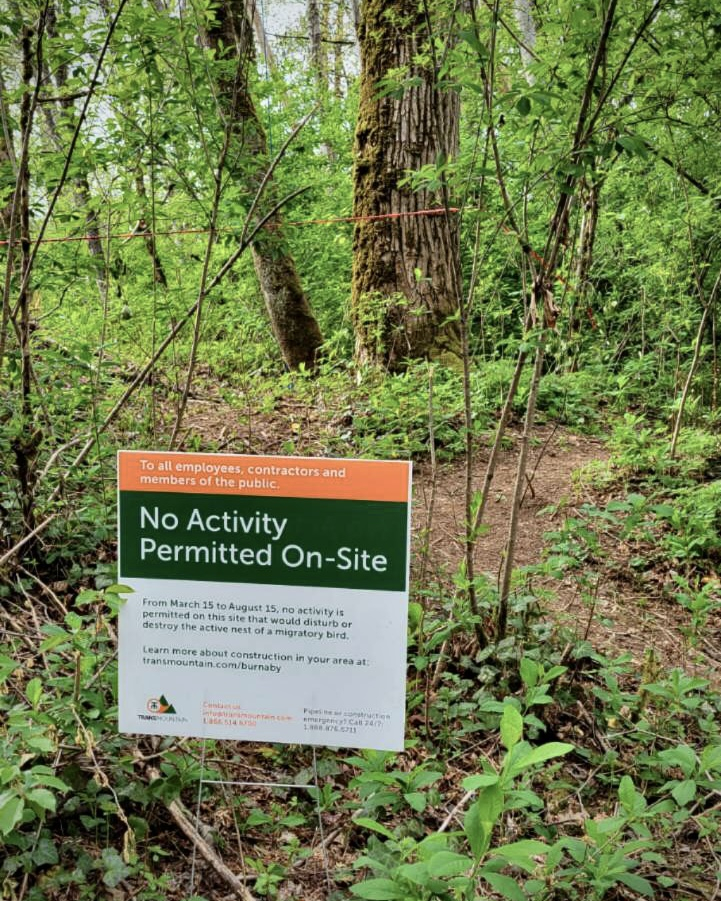Support strong Canadian climate journalism for 2025
Back in spring 2021, hope soared for many people around the world when a tiny Anna’s hummingbird stopped construction on a segment of the Trans Mountain pipeline expansion project (TMX) — now Canada’s largest infrastructure project, costing Canadians more than $21.4 billion.
Bird nests of migratory species including Anna’s hummingbird are protected while in use under the Migratory Bird Convention Act.
I was there that day when the federal wildlife officer shouted, “Stop the work!” and silenced the chainsaws. Those of us on the scene had been watching as a tree-cutter sliced down a tree where an Anna’s hummingbird nest had been. The wildlife officers investigated and, sure enough, found the teeny destroyed nest smashed on the ground, along with a single egg.

I was a mix of emotions: adrenalized because we had finally caught Trans Mountain in the act of environmental destruction; furious because this project is destroying so many nests and other habitat along the 1,150-kilometre route; and also so sad for the poor mama hummingbird.
We all saw the tree fall and Trans Mountain eventually admitted the nest was destroyed. So what is the price tag for this illegal act, for destroying a federally protected nest? Initially, Trans Mountain was fined $88,000 for destroying several nests, including the hummingbird’s nest and egg. But recently, that fine was reduced to just $4,000.

When news of the fine reduction was released in early January, I received many calls from disappointed people wishing Trans Mountain would be fined more, and that birds would receive more protection as set out in Canadian law.
Aren’t fines used to deter illegal activity?
In our current regulatory scheme, the monetary value of one Anna’s hummingbird nest — $88,000 or $4,000 — is inconsequential and of zero deterrent value to the project proponents of a $20-billion-plus-plus project. It’s questionable now whether it’s even worth paying a "qualified environmental professional," a term Trans Mountain uses, to complete the required bird surveys to find nests.
Is our federal government serious about the application of laws (and associated fines) to protect the environment, in this case, birds? Canada loudly claims our oilsands are regulated and principled but are they really? To understand more, I turned to the Canada Energy Regulator’s tribunal investigation and findings directly.
Big surprise! The guilty ruling and associated fine are not even about nests. It’s about the company not properly controlling or overseeing the people working on the project.
From the findings, evidence shows “Trans Mountain … failed to provide information between crews, failed to control the activities of workers, and failed to ensure that required environmental mitigation was being implemented. It also shows that Trans Mountain failed to transfer or communicate key information, including knowledge of enhanced procedures.”

Managing workers appropriately is surely a matter of supreme importance for companies under the regulatory oversight of the Canada Energy Regulator — a body specifically in place to regulate, in its own words, a “high-hazard industry such as the oil and gas sector.”
If we want our industry to be regulated, shouldn’t our regulator be able to wield the power of a fine that hits where it hurts?
Wouldn’t it be something if that little bird still has the power to sway global opinion so that countries wanting to do right by their energy choices don’t fall for the veneer of Canadian oilsands marketing propaganda, which tries to pass off the world's most-polluting oil product as principled and regulated?
Where I live in the territory of the Tsleil-Waututh, Squamish and Musqueam (colonially named Burnaby) and beside the terminus of the new pipeline, Anna’s hummingbirds have already begun their beautiful courtship dances. The males rise like helicopters straight up for six or seven storeys before pausing, then plunging towards Earth — usually faster than a human eye can follow. They screech to a stop at the very last second. It’s a heart-lifting sign of spring about to arrive.
To paraphrase writer and historian Rebecca Solnit: the future is not yet written, and in that space, there is possibility for all kinds of unknown and surprising futures. Even futures where hummingbirds do everything they can — and succeed in stopping pipelines.
Sara Ross is a co-founder of the Community Nest Finding Network, a group of volunteer ornithologists who ensure nesting birds are given the full legal protection they are entitled under Canadian Law. The group's geographical focus was the forested corridor of the Trans Mountain pipeline expansion project, mostly in Burnaby, B.C.






Comments
Great work, Sarah.
That Sarah and others are doing this work gives me hope. Thank You!